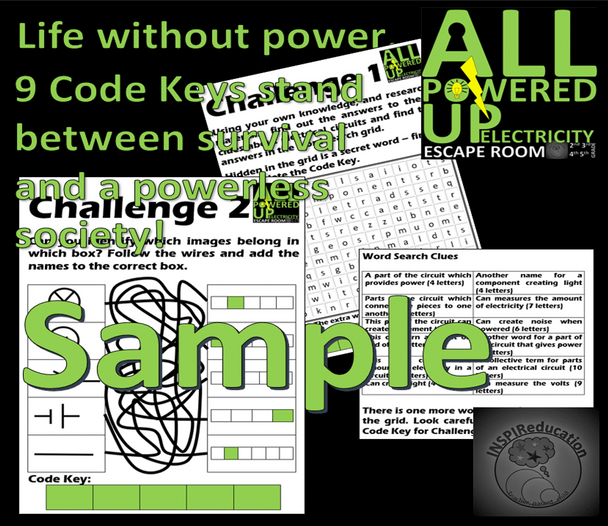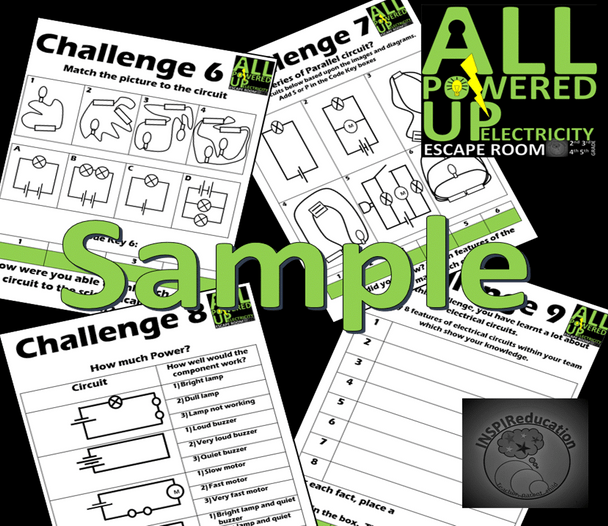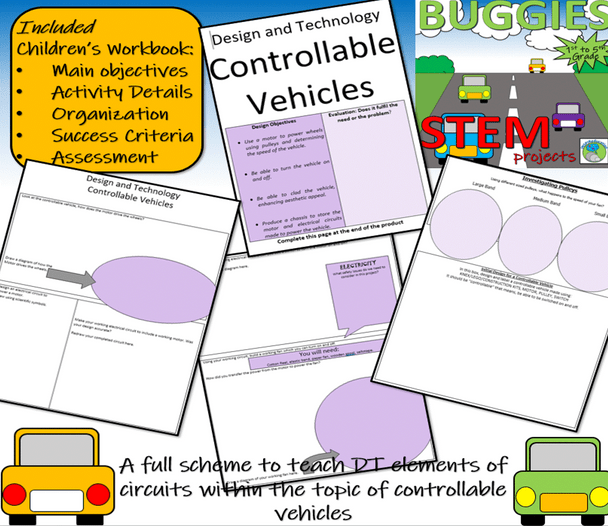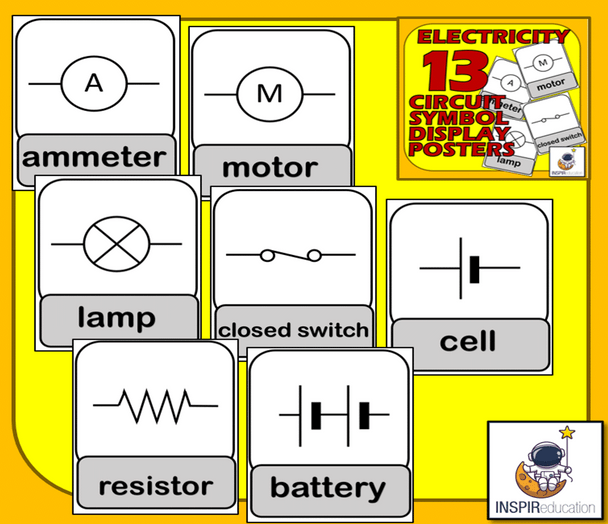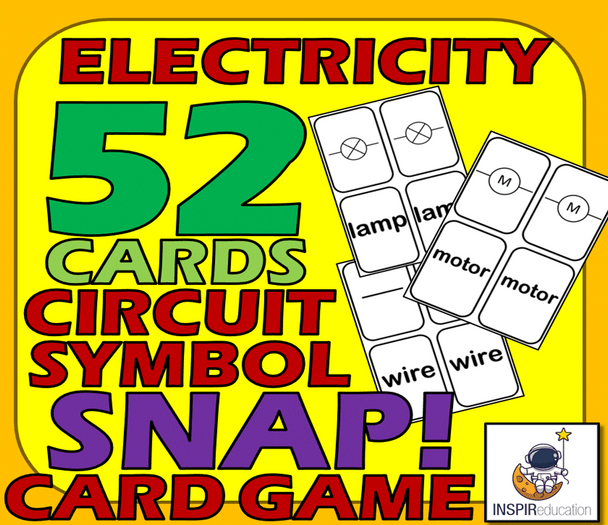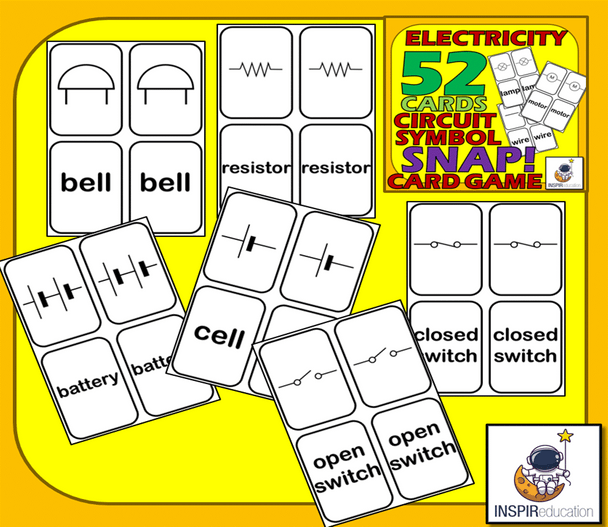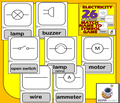Description
This bundle brings together our resources for the science theme of Electricity. From learning the visual representations of electrical components and their names, successfully completing an Escape Room using Electrical and Scientific knowledge, to using their scientific hands-on skills to complete a STEM project using motors to create fans and controllable vehicles. We feel that this bundle provides everything you need to support your students in learning all about electricity in a fun, interactive and stimulating way!
Included in this bundle:
- "All Powered Up" Electrical Escape Room
- "Buggies" Electrical STEM Project Pack, lesson plans, resources and certificate
- 54 Circuit Diagrams to Make Electrical Circuits (series and parallel)
- 13 Electrical Component Posters (labelled)
- 13 Electrical Component Images and 13 labels for students to match and learn
- 52 Card Snap! Game for 2-4 players - matching component images with images, names with names and images to names.
"All Powered Up" Escape Room
Using an Escape Room to develop curriculum knowledge is an exciting activity that will inspire learners from 3rd Grade to 6th Grade.
The curriculum content of this Escape Room is linked to:
Electrical Circuits
The aim of the Escape Room is to provide jeopardy for the children to work under pressure to solve 9 clues to save them from saving the world from a Global Power Drain.
Before beginning, you will need to prepare the following:
- A copy of the Pupil Workbook for each group
- A set of table activities for every group – prepared beforehand and given to each group after they have all completed each Code Key activity
- IT sources and research materials
- Initial Starting Script sharing the problem to the children
- Completion Script celebrating the completion of the challenge
Children do not need prior knowledge of the topic above to complete this Escape Room, as the research will support the answers and each Code Key is supported with several clues. This Escape Room is ideal as a review of learning.
The activity begins by the teacher reader the Initial Message received. It clearly tells the children that they are required to save the Earth from a Global Power Drain that will change the way we live forever. The only way they can save the Earth is to solve 9 Code Keys. Failure is not an option for the future of the Earth!
What follows are 9 activities which the children must solve to discover the code to move onto the next activity.
Each activity focuses and builds the children’s knowledge on many aspects of Electrical Circuits.
The 9 activities are based on the following outcomes:
- Electrical Circuit component names
- Electrical Circuit component images and names linked
- 9 scientific images and names
- Identifying errors in the construction of simple circuits
- Predicting what will happen with built circuits
- Linking scientific diagrams of circuits with “pictures” of circuits
- Series and Parallel circuits
- Power usage
- Reviewing the 8 Code Keys and identifying what we have learnt/revised about Electricity.
When all 9 activities are completed, and the children have gained the correct Code Keys from each activity, the teacher can read the final communication detailing how the children have been able to save the Earth.
Setting up the Escape Room
1. Children should be split into groups of no more than four and be placed in their own work space.
2. Access to IT and research materials should be provided to allow children to research answers to questions and review their own knowledge, as well as checking answers.
3. Each group should have a Code Key Booklet and decide on a team name
4. Read the Initial Message to the children to set the challenge in context. Discuss what this means, and what the activity entails.
5. Hand each group a copy of Code Key 1. Agree with the children a set time to complete the problem in – this ensures that the children stay on task and maintains the Escape Room element of working under pressure.
6. At the end of the time, children should have filled in the Code Key in their booklet. The teacher can then check the accuracy of all the groups and talk through the responses the children should have.
7. Move on through the remaining challenges until all 9 have been completed.
8. For those groups who have been successful, they are then able to read the completed statement where they find out if they have escaped the Escape Room and saved the Earth!
There are other ways of running Escape Room activities, for example, each activity could be set up on 8 tables (with the 9th Challenge the groups all doing at the same time) and the children then move from table to table completing the activity. This would reduce the need for as many resources, and access to non-fiction sources and Internet Resources could then be targeted at specific Challenges.
The Escape Room should last for 2 hours.
STEM: Controllable Vehicles using Electrical Circuits
This product focuses on the study unit area of controllable vehicles - electrical circuits, motors and pulleys - from Grades 4 and 5 (US) and Years 5 and 6 (UK).
Included are eight lesson plans are placed in a clear teaching sequence of varying lengths taking the children on a journey through:
- researching controllable vehicles, including how they work,
- gathering evidence from various sources,
- developing ideas for different techniques of control in electrical circuits,
- evaluating pulleys working in different directions,
- evaluating different electrical circuits for different purposes,
- focused practical activities for circuits and strengthening joints,
- building and evaluating models of their ideas,
- redesign based on outcomes,
- building final controllable vehicle,
- overall evaluation of vehicle,
- assessment based on initial objectives
As well as the lesson plans, a Student Workbook is also provided which guides the students through developing and reflecting upon their working through working systematically and methodically through the design and make process. It supports students in questioning them on what they have seen, understood, and how they can use this to further develop their own learning.
For further visual information, please see the preview which includes the lesson plans and the student workbook. We have used this resource in their classrooms to great effect. It has really structured learning and focused students on not just the process and purpose of the activities, but also on successful outcomes too. Not only that, but the use of the pupil workbook, the children have a map of the journey they have undertaken to research, plan, do, review their project.
Making Electrical Circuits using Circuit Diagrams - Series and Parallel
This product has been designed and used by our students to support learning in the study unit of electricity. Using circuit diagrams to create their own circuits and enhance their knowledge of how electricity works and reasons why electrical circuits can fail.
Key objectives taught:
- Follow circuit diagrams to make a range of circuits
- Identify what happens when circuits are constructed and why.
- Be able to explain why a circuit does not work using scientific vocabulary based on observations of both the circuit diagram and the made circuit.
- Predict from given circuit diagrams whether a circuit will work or not and offer reasons why
- Making a range of electrical circuits using an array of electrical components (including switches, bulbs, cells/batteries, buzzers, bells, motors and resistors)
- Students to trouble shoot errors and explain what has gone wrong.
- Series and parallel circuits, the strengths and weaknesses of both.
- Observing how power is used when multiple components are used in both a series and parallel circuits.
This product contains 54 circuit diagram design cards which grow in complexity. The include a wide range of circuits for students to build, some with obvious areas which would cause a circuit to not work and others which are more complex to identify.
Starting with simple series circuits and one component with a power source, other elements are soon added including switches and more batteries.
As the circuits grow in complexity, so too do the components being used and the order they are placed.
Following on from series circuits, a range of parallel circuits are then introduced which allows the students to observe the difference between the two circuits. A growing awareness of when each circuit could and should be used is developed as students see the benefits and drawbacks of each.
This product does not necessarily need components to use. We used them circuit diagrams to predict whether each of the circuits would work, what would happen in each, and identify the components used in each, and finally, describe how we would make each. Following this, as a class, we had the components and students worked in pairs to create each of the circuits on the diagrams. Once completed, the circuit diagrams were passed from one pair to another - with each pair making many of the different circuits within the sessions.
The benefit of this product meant that we could set up a Science Exploration area within the classroom for students to go and use the circuit components and create their own circuits by following the diagrams on the cards. Many then went on to explore and create their own, recording their own diagrams on small student whiteboards which we then copied and added to those in the collection. Therefore students started making each others diagrams.
We hope that this product works as well in your class as it did in ours and that your students enjoy and engage with it as much as ours did, for many weeks following our science theme of Electricity too!
Electrical Components: 13 Images and Labels to display in the classroom
We have produced 13 labelled, electrical circuit component posters to display in the classroom and support students learn the visual representation and name of each component. Each poster is A4 in size, but can be enlarged or reduced depending on teacher need through copying bigger or smaller.
The visual components included are ideal for 4th - 6th grade when learning about electrical circuits, creating their own and investigating components, their roles and how they can be used in circuits. The 13 posters include:
- ammeter
- motor
- lamp (on and off) (2 posters)
- closed and open switch (2 posters)
- resistor
- cell and battery (2 posters)
- wire
- voltmeter
- bell
- buzzer
Each poster is clearly presented, and in black and white, making the images sharp, and also more cost effective for the teacher to print copies.
Simply purchase, download, print and display!
These posters supported our students in their Electrical Circuit diagram work once they had made a range of working circuits.
We hope that you find them useful in your classrooms too.
Electrical Circuits - Matching Component to Name
We have produced 13 electrical circuit component posters and 13 component labels to display in the classroom and support students learn and match the visual representation of each component to its' name. Each poster and label are printed on A4 paper, but can be enlarged or reduced depending on teacher need through copying bigger or smaller.
The visual components and labels included are ideal for 4th - 6th grade when learning about electrical circuits, creating their own and investigating components, their roles and how they can be used in circuits. The 26 images (component diagrams) and labels include:
- ammeter
- motor
- lamp (on and off) (2 posters)
- closed and open switch (2 posters)
- resistor
- cell and battery (2 posters)
- wire
- voltmeter
- bell
- buzzer
Each image and label is clearly presented, and in black and white, making the images sharp, and also more cost effective for the teacher to print copies.
Simply purchase, download, print and use with your students to match the images to the label, again and again and again - ensuring they have learnt which component is called which name!
These images and labels supported our students in their Electrical Circuit diagram work once they had made a range of working circuits and were drawing their own scientific diagrams.
We hope that you find them useful in your classrooms too.
SNAP! Card Game
We have produced this game of SNAP! using 13 common electrical circuit component images and their associated names placed onto 52 playing cards. The aim of the resource is for students to recognize quickly, and be able to name electrical components when working in the study unit of electricity in science sessions.
The visual components included are ideal for 4th - 6th grade when learning about electrical circuits, creating their own and investigating components, their roles and how they can be used in circuits. The 13 images and labels included in the game are:
- ammeter
- motor
- lamp (on and off) (2 posters)
- closed and open switch (2 posters)
- resistor
- cell and battery (2 posters)
- wire
- voltmeter
- bell
- buzzer
The game is easy to prepare - simply download, print, laminate to ensure the longevity of the resource, cut and then play. Full instructions are included within the resource - however, your students will soon develop their own, more challenging versions of the game, ensuring they are learning their science as they play!
Great for Science Centers too!
Instructions for the game:
Number of players – 2 to 4
Solo play can be done using a simple matching/memory game where the cards are turned face down and the students must match the image to the name (or another image).
Preparation
Print out the game cards. Laminate to ensure a longer life, then cut each of the cards out leaving a small border around the thick black edge.
Playing the game
Deal the cards out between each of the players.
Decide on who is going to go first. First player lays down their first card, quickly followed by the second player and so on. Each card is placed on top of the last.
If the card laid down is the same as the card preceding it, the first player to shout “SNAP!” wins the cards. They then start the next round by laying down the first card.
Players are out if they lose all of their cards. The winner is the first player to collect all cards.
There are many variations of this game and your students may want to change the rules, play their own variations etc. Ultimately, the teaching objective is to learn the symbols and names of electrical circuits. This is done through playing this exciting and fast paced game.
Best wishes
INSPIReducation




